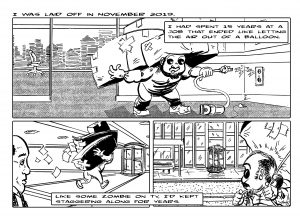By Sandy Jimenez
Special to Campus News
When I was in elementary school in the 1970s, teachers would punish me and my classmates by confiscating our comic books along with our candy. But their disdain for comics failed to deter me.
As a fine arts major at The Cooper Union, I and fellow students met in secret to discuss comic books and teach each other the art form. After college, I became a comic book artist.
Today, comic books and graphic narratives are recognized as legitimate art forms with the capacity for profound cultural commentary. I believe they are among the most accessible and yet sophisticated methods of storytelling.
That is why I’ve returned to the classroom at The City University of New York, where I’m a master’s student and adjunct faculty member studying and teaching comics and graphic narrative as art and literature.
Making comics turns writers into illustrators and people who draw into poets, dramatists, and novelists. And everyone who likes comics can make them.
Here are some tips on how to start.
First, warm up
Try this exercise developed by CUNY Professor Sara Gómez Woolley: Write and draw a panel that expresses an action in a sentence. Depict a simple action, a gag, an idea: Man falls down the stairs; woman hurls frisbee out of city park.
Emboldened by the glory of making a work of narrative art, you’ll be ready to make another, with dialogue and a caption. Now try redrawing or splitting both of those single panels into two panels that make a two-part sequence. Do this and you are ready to begin.
Read, read, read

There is nothing quite so divisive as a top 10 list, so I won’t offer mine here. But learn the comic book artform’s classic and contemporary works of note: the old stuff, the new stuff, the Pulitzer Prize-winning stuff, graphic novels, graphic memoir, edgy independent stuff, experimental zines, collections of the great newspaper strips. Read them all. You wouldn’t write a prose novel without having read several. Knowing and loving comics begins with literacy and reading — so read comics.
Start with the story
Before you draw a single line, create a story for your eight- to10-page project. Your story must have a beginning, middle, and end. Write a single sentence for each stage. Your first sentence should convey the situation, setting, and who or what will start the action, or plot. The second sentence must tell us what action is and what happens. The last sentence must conclude and resolve the action and conflict that was shown in the first two sentences. Like so:
1) On a city street, a dog notices a cat.
2) The dog chases the cat through an alley.
3) The dog encounters an escaped tiger when he turns the corner.
Keep the story simple and action-driven, free of unnecessary adjectives and extraneous information so that the plot emerges.
Write a script
Familiarize yourself with the comic book script formats. Samples abound online. You can practice creating a script by taking a page of a comic book story you admire and reverse engineering the script from the finished product.
Understand the power of the panel
What you show in a panel is the foundation, the atomic structure of comic book storytelling. A comic’s panels and pages are used to convey instances and moments in time. Our example above of the dog getting his comeuppance by chasing and nabbing a much bigger cat than he expected can be told in as little as two panels, or a panel per sentence, or scores or even hundreds of panels. One rule of thumb to remember is that the number of panels you devote to depict a single action in your script can speed up or slow down time.
Design your characters
Designing a character is a kind of casting process in which you are creating your actors as opposed to finding them out in the world. In our example, ask yourself what kind of dog is it? Is it a posh, confident Park Avenue purebred? Or is this a stray lounging on the sidewalk on a hot afternoon? What does the cat look like? Answering these questions will populate your story with colorful characters that captivate readers.
Learn panel layouts and composition
For your first story, stick to one size for your panels. Later, you can vary the sizes. And consider the “gutter” — the empty space between the panels. Manipulating the width of the gutters can make transitions fast, slow, smooth, rough, etc. to make readers feel what you want them to.
Show, don’t tell
While the writing of dialogue and narration are crucial, you must always think about how your story’s elements, characters, and events are seen as images first, rather than how they are described as text. Don’t write, “It was a dark and stormy night.” Illustrate the dark and stormy night that is the setting of your story.
Start small to finish big
Aim for an eight- to 10-page work. This length will ensure that you engage all aspects of the process of making a story in the comic book form with equal effort and focus. Scaling your first project correctly will give you control and allow you to finish with a work that can be assessed and revised and learned from.
Creating your first comic book will be a labor-intensive, artistically challenging, and mentally strenuous undertaking. But if you build up your skills and vision in stages, increasing your challenges with progressively bigger and more ambitious projects, you will get results that will strengthen as well as encourage you. Comic books and graphic novels will reward you, the creator, in proportion to your efforts.
See you in the funny papers.
Sandy Jimenez, an American comic book artist, writer, and editor of Dominican descent from the South Bronx, is a Biography and Memoir master’s student at the CUNY Graduate Center and an adjunct teacher at New York City College of Technology.









Facebook Comments